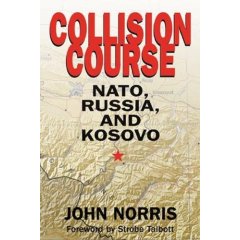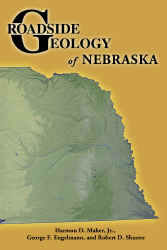Laurentian Reviews
Summer/Fall 2005
 Collision Course: NATO, Russia and Kosovo
Collision Course: NATO, Russia and Kosovo
By John Norris ’87
Praeger, 2005
The military confrontation between NATO and Serbia over Kosovo
was the last episode of the nasty conflict which engulfed the
former Yugoslavia in the 1990s. Kosovo, an Albanian-
populated province of Serbia, was occupied by the Serbian military
in October 1998 in response to resistance by resistance forces
of the Kosovo Liberation Army supported by Albania. Unable
to secure a cease fire and UN Security Council sanctions, the
United States and its NATO allies threatened a bombing campaign
against Serbia if Serbia did not comply and remove Serbian
military forces.
When negotiations with Serbia failed,
NATO began a 78-day bombing campaign on March 21, 1999, to
compel Serbia to observe a cease fire and remove its forces. This
strategy followed the NATO threat to bomb Serbia if it did
not remove its forces from Bosnia in 1995. It led to
the Day Ten Accords and Serbian withdrawal, and the introduction
of NATO peacekeeping forces.
John Norris’s
book is a first-hand account of the Kosovo war and the extended diplomatic
negotiations to end it. As Deputy of Secretary of State Strobe Talbott’s
communication director, Norris was intimately in touch with the negotiations
and the various views and political positions of the key participants: the
U.S., NATO and Serbia. Kosovo ironically was NATO’s first war in
its 50-year existence and the first modern war which was terminated by aerial
bombing, which had been threatened. Bombing was the choice because neither
did the United States nor NATO wanted to commit ground troops to liberate Kosovo.
Diplomatic negotiations with Serbia were hampered by Russian
support of Serbia, a long-time ally. Russian political
and military support of Serbia was limited however by Russian
economic problems and military weakness vis-à-vis NATO
power. Ultimately, Russia became a reluctant supporter
of Serbia withdrawal and the introduction of NATO peacekeeping
forces, but not before unilaterally trying to impose its military
in Kosovo in a stealth operation.
In this
study of the Kosovo War and its protracted negotiations and
lucid description of the U.S. and NATO strategies, John Norris had done a commendable
job in constructing a detailed case study and analysis of decision-making by
the participants. Once
would hope that at some time the inner workings of the Kremlin would reveal
Russian thinking and actions on Kosovo. Until then, we have John Norris’s
fine account of American and NATO negotiations to shut down the war in Kosovo
and expel Serbia.
Robert N. Wells Jr.
Professor Emeritus, Government
 Roadside Geology of Nebraska
Roadside Geology of Nebraska
By Robert Shuster ’76 et al.
Missoula: Mountain Press, 2003
As you pack the car and kids to head west to emulate the route
of the remarkable Corps of Discovery led by Lewis and Clark
during this anniversary period, throw a couple of books in
the car with you. Bob Shuster ’76, associate professor
of geology at the University of Nebraska at Omaha, has co-authored Roadside
Geology of Nebraska, a very readable and informative narrative
of the subtle geologic features of this Plains state. This
is one of a long-standing series of “Roadside Geology” guides
that have been improving continually in scope, style and quality
of composition over the past 10 or 15 years, and a fine example
of the genre.
Between
its covers one finds a concise, comfortably readable summary
to the geology of Nebraska which sets the groundwork for a
route-by-route description of the most fascinating elements
of the geology of the region. The authors clearly appreciate
the relationships between bedrock and surficial processes that
form the landscape. A significant virtue of this book
is the keen ability of its authors to recognize, interpret
and make understandable for all readers the historical sequence
of the Earth processes that have created Nebraska’s landscape. Features
that have been part of the American experience such as Scott’s
Bluff and the Sand Hills are given real meaning for visitors
and residents alike.
Clarity
of explanations is enhanced further by frequent illustrations
with photos, route maps and the use of shaded relief maps created
from the new USGS DEM series. The latter in particular
highlight the fabric and texture of the prairie landscape so
as to amplify the brief discussions in the text. Together,
text and illustrations make insightful vignettes that explain
the geology and often demonstrate its strong influence on the
history of the region.
The
authors have not forgotten the rich paleontological heritage
of Nebraska. Marine reptiles and fish from oceanic deposits
of the age of dinosaurs, the Mesozoic Era, and Tertiary mammals
are well represented in Nebraska. The authors document
the locations where travelers can view the most spectacular
specimens. Ashfall Fossil Beds State Historical Park
displays the rich, 10-million-year-old mammal fauna of North
America in the Miocene Epoch, including camels,
rhinoceros, horses and may others entombed at a waterhole by
six feet of volcanic ash that fell over the region. One
wonders how long these remarkable fossils will be available
to the public, since the state of Nebraska has laid off its
entire paleontological staff at the state museum even though
the paleontological materials are a major tourist attraction.
Those scientists have been responsible for the work of discovery,
excavation and curation of many sites like the Ashfall Fossil
Beds. For now, the museum displays and these geologic
sites represent a remarkable record of the history of life
on Earth.
So
many of the principles of geology are clarified by the sites
and vistas described that the general tourist user of this
text will feel well acquainted with the basis and the importance
of geology to our lives after a trip through Nebraska! The
relationships between geologic processes and climate, both
short-term and long-term, are dramatic. A site I strongly
recommended is the resting place of the Missouri River steamer Bertrand, which
carried supplies to the gold miners in South Dakota. It
sank with a full cargo in 1865, and the river meander in which
it rests was cut off and completely silted in with the steamer
still on the bottom, thus preserving ship and contents in perfect
detail. Goods and supplies of every type have been painstakingly
excavated and curated. Both the rapidity of river migration
and the detail of presentation of cargo shown in the site museum
displays impress one with this geologic process, essentially
fossilization, and clarify how dinosaurs were similarly entombed
in river sediments millions of years earlier.
If
you follow the path of Lewis and Clark or go west on the Oregon
Trail, you will appreciate the geology around you far better
with Bob Shuster’s book at your side.
J. Mark Erickson
Chapin Professor of Geology

